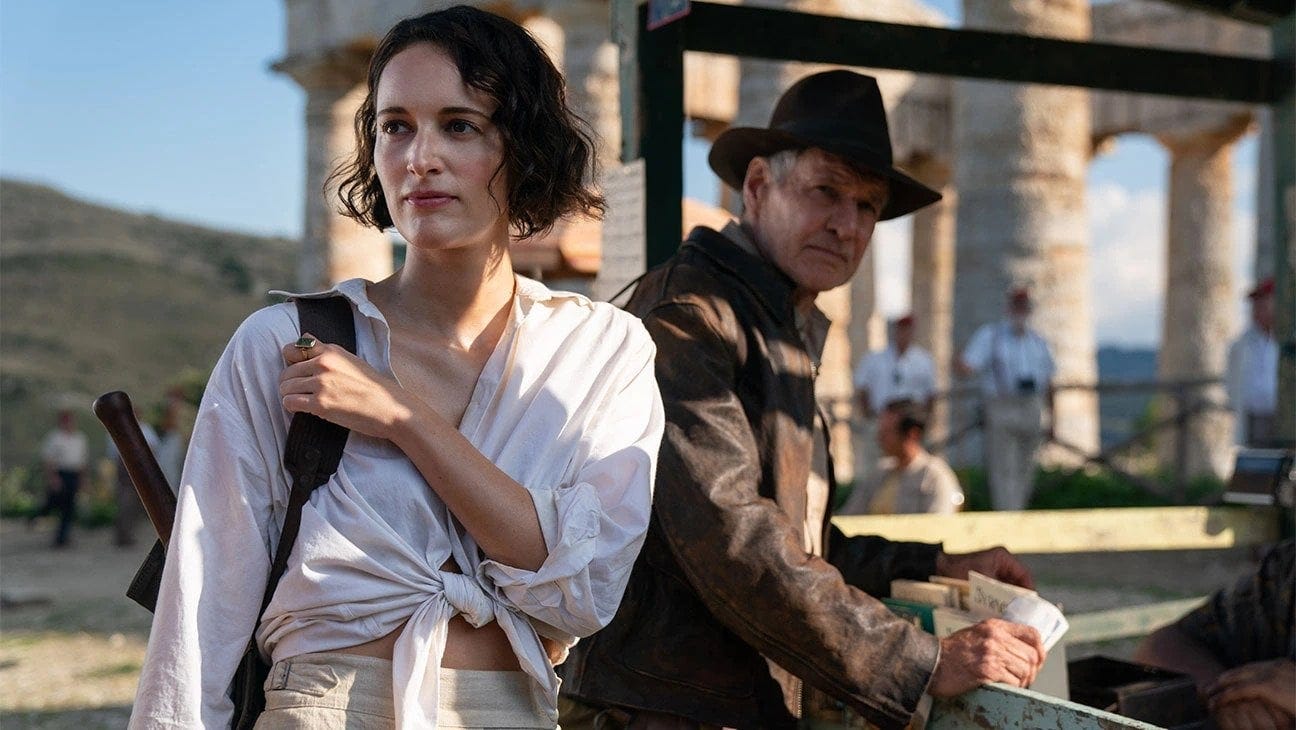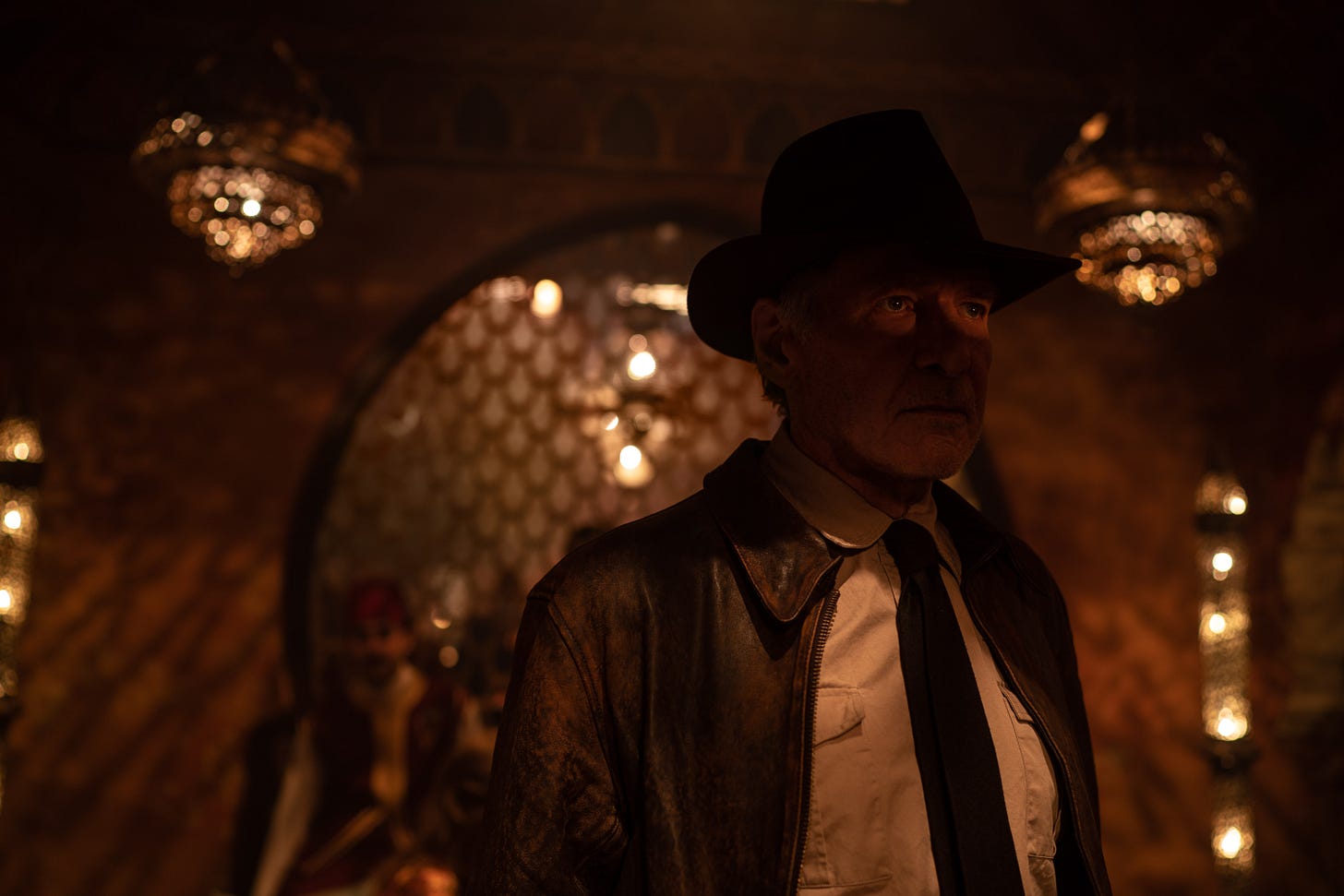Indiana Jones and the Dial of Destiny: The Lure of Adventure.
Harrison Ford gives it his all in an epilogue to the epilogue.

In 2012, George Lucas, once the champion of the independent filmmaker, who famously used the financial capital he generated from Star Wars to forever separate himself from the Hollywood ecosystem, became (even more of) a billionaire.
Lucasfilm, his aptly-named production studio, alongside the full creative rights to his two most beloved properties, Star Wars and Indiana Jones, were sold to The Walt Disney Company wholesale for just a shade over four billion dollars (yes, with a b).
And while Lucas would Scrooge McDuck his way into kinda-sorta-retirement over the next few years, Disney’s next move was pretty clear: getting to work on recouping their investment. They didn't waste any time.
Within seven years of the Lucasfilm purchase, the company, now a subsidiary in the larger Mouse Machine, would release the Star Wars sequel trilogy, two anthology films and had begun work on various TV series set within the franchise’s ever-complex mythology.
But the future of Indiana Jones, if any, was a little tougher to pin down, if only because Lucas and longtime creative partner, Steven Spielberg, had already beaten them to the punch.
2008’s Indiana Jones and the Crystal Skull, released (and set) nineteen years following The Last Crusade, was meant to be a swansong, a final goodbye, a tip of the iconic fedora, even if it didn’t necessarily need to be.
I mean, The Last Crusade ended with Harrison Ford’s titular archaeologist/adventurer, quite literally, riding off into the sunset. How do you top that?1
The Indiana Jones films were, at the their core, always meant to be callbacks to the swashbuckling pulp heroes of the ‘30s and ‘40s Lucas and Spielberg had grown up with, this, something the original trilogy epitomized.
But Crystal Skull, perhaps burdened by exception and creative overindulgence, couldn’t quite hit that mark. Whether it was the aliens who revealed themselves during the film’s climax, the addition of Indy’s long-lost son, Mutt (Shia LaBeouf) or the “nuking of the fridge”, “mixed reception”, for many, was too generous an assessment (for the record, I remember liking it but I was nine. C’mon, man! Aliens are cool!).
Indiana Jones and the Dial of Destiny, which came to theatres this past Friday, has been touted as the franchise’s final film and seems to be, for better or worse, acutely aware of the legacy it is expected to uphold.
For the first time, Lucas and Spielberg aren’t actively involved creatively, although they are credited as executive producers.
Instead, director James Mangold (Walk the Line, Logan, Ford v Ferrari) and three other accredited writers, try to “play the hits” the best they can (A search for ancient artifacts! Tightly-choreographed chases! Damn Nazis!) while also acknowledging that, try as we might, there is no stopping the passage of time.
To hear Harrison Ford promote this movie over the past few months, it is clear he cares deeply for the role (which, compared to his general apathy and on-record, occasional disdain for Han Solo and Star Wars, is absolutely hilarious - anyway) and he brings all the gravitas and emotion he can to a character he has embodied for the better part of 40 years.
And fortunately, for both Ford and us, his adoring viewing public, the film mostly measures up with a similar enthusiasm, save for a few nest-of-snake sized missteps along the way.
The Indiana Jones we find at the beginning of Dial of Destiny has long since left his globe-trotting adventuring behind. It is July of 1969 and man has just landed on the moon: who needs treasure hunters?
You get the feeling life has somewhat passed him by.
On the verge of retirement from his university teaching-gig and separated from his wife, Karen Allen’s Marion, (for reasons I won’t spoil here) Indy, who quietly lives alone, struggles to connect with his students and isn’t afraid, with baseball bat in hand, to give his much-younger neighbours the business for playing the Beatles too loud.
But when his goddaughter, Phoebe Waller-Bridge’s quick-on-her feet Helena Shaw, the daughter of Indy’s long-ago archeologist friend Basil Shaw (Toby Jones), appears asking for help, who is he to say no?

Helena is after the Archimedes' Dial, an artifact of such potential power, that her father went a little bananas trying to find it. Named after the Ancient Greek mathematician, it is said to locate “fissures” in time, no doubt a particularly dangerous thing to fall into the wrong hands.
And in this particular case, it is former Nazi hands, those of Mads Mikkelsen’s Jürgen Voller, who wishes to use the eponymous Dial’s supposed time-travel capabilities for his own ends, as he and his cronies look to alter the course of history.
There’s clear-cut nostalgia element at play here: the premise itself (Indy vs Nazis), the return of familiar faces spoiled by the marketing (hello and welcome back, John Rhys-Davies, we missed you!) and an around-the-world adventure that harkens back to the Raiders of the Lost Ark and Last Crusade days of old (a prologue set in 1945, with a digitally de-aged Ford fighting his way through a Nazi convoy, speaks to this).
Even Mikkelsen’s Nazi antagonist, with his prominent glasses and faux-polite sneer, recalls Raiders villain, the late Ronald Lacey’s SS agent Toht, with such familiarity you can’t help but wonder if it is intentional (it probably is).
Such blatant attempts at returning to what worked thirty years ago, while mostly successful, can be, frankly, a little manipulative, leaving the movie feeling somewhat lost at times, as it tries so hard to put the public disappointment of Crystal Skull in the rearview mirror. This is the epilogue you want, dammit!

Anchored by Waller-Bridge and Ford though, it works, both shining with a genuine emotional sincerity that speaks to their characters and what we know (and later learn) of their respective histories as their dynamic develops (for example, Helena isn’t quite as altruistic as her godfather).
And visually, the film is (relatively) strong, Mangold, having proven himself as a director with a natural gift for fast-moving, kinetic energy. An early-movie chase through the sun-soaked streets of Tangier is a particular highlight, if only because, well, you can actually see it.
This isn’t an Indiana Jones problem specifically (it is an industry-wide issue) but too often during action-driven moments, whether it was a fight atop a moving train or a chase through the New York City subway tunnels, I’d find myself struggling to keep up with what was happening on screen, having to trust my own storytelling intuition to fill in the blanks I missed (“did he just punch that guy? Probably!”).
It is small potatoes compared to everything else Dial of Destiny does well though, however. Some might (rightfully) take issue with, at times, an over-reliance on the franchise’s past but if it is truly goodbye to Harrison Ford as Indiana Jones, then it is an adventure more than worthy of the name.
Into the sunset, one last time.
Lucas tried, briefly, to recapture the magic in the 1990s, with The Young Indiana Jones Chronicles, a television series focusing on the character’s adventures as a younger man (Harrison Ford would reprise his role as adult Indy in one episode set during the 1950s). Shot on-location at various locales around the world, it received praise but due to high costs, was cancelled after just two seasons. Episodes were later edited into feature-length films and if you’re so curious, you can find them on Disney + (who, unfortunately, are not paying me to promote their product).




